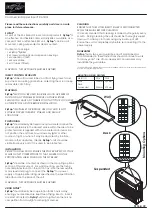
Subject to change without notice
24
Triggering and timebase
increased (compared with C short-circuited), then the test
voltage leads the reference voltage and vice versa. This
applies only in the region up to 90° phase shift. Therefore C
should be sufficiently large and produce only a relatively small
just observable phase shift.
Should both input voltages be missing or fail in the X-Y mode,
a very bright dot is displayed on the screen. This dot can burn
into the phosphor at a too high brightness setting (
INTENS.
knob
) which causes either a lasting loss of brightness, or in
the extreme case, complete destruction of the phosphor at
this point.
Phase difference measurement
in DUAL mode (Yt)
Phase differences between two input signals of the same
frequency and shape can be measured very simply on the
screen in Dual mode. The timebase should be triggered by the
reference signal (phase position 0). The other signal can then
have a leading or lagging phase angle.
For greatest accuracy adjust the timebase for slightly over
one period and approximately the same height of both signals
on the screen. The Y deflection coefficients, the timebase
coefficients and the trigger level setting can be used for this
adjustment, without influence on the result. Both base lines
are set onto the horizontal graticule center line using the Y-
POS. knobs before the measurement. With sinusoidal sig-
nals, observe the zero (crossover point) transitions; the sine
peaks are less accurate.
If a sine signal is noticeably distorted by even harmonics, or
if a DC voltage is present, AC coupling is recommended for
both channels. If it is a question of pulses of the same shape,
read off at steep edges.
It must be noted that the phase difference cannot be deter-
mined if alternate triggering is selected.
Phase difference measurement in DUAL mode
t = horizontal spacing of the zero transitions in div
T = horizontal spacing for one period in div
In the example illustrated, t = 3div and T = 10div.
The phase difference in degrees is calculated from
Relatively small phase angles at lower frequencies can be
measured more accurately in the X-Y mode with Lissajous
figures.
Measurement of amplitude modulation
The momentary amplitude u at time t of a HF-carrier voltage,
which is amplitude modulated without distortion by a sinusoidal
AF voltage, is in accordance with the equation
where
U
T
= unmodulated carrier amplitude
Ω
= 2
π
F = angular carrier frequency
ω
= 2
π
f = modulation angular frequency
m
= modulation factor
The lower side frequency F-f and the upper side frequency
F+f arise because of the modulation apart from the carrier
frequency F.
Figure 1
Amplitude and frequency spectrum for AM display (m = 50%)
The display of an amplitude-modulated HF oscillation can be
evaluated with the oscilloscope provided the frequency spec-
trum is inside the oscilloscope bandwidth. The timebase is set
so that several cycles of the modulation frequency are visible.
Strictly speaking, triggering should be external with modula-
tion frequency (from the AF generator or a demodulator).
However, internal triggering is frequently possible with nor-
mal triggering using a suitable trigger level setting and possi-
bly also using the time vernier (variable) adjustment.
Oscilloscope setting for a signal according to figure 2:
•
Y: CH. I; 20mV/div; AC.
•
TIME/DIV.: 0.2ms/div.
•
Triggering: Normal; with LEVEL-setting; internal
(or external) triggering.
Figure 2
Amplitude modulated oscillation:
F = 1 MHz; f = 1 kHz;
m = 50 %; UT = 28.3 mVrms.
If the two values a and b are read from the screen, the
modulation factor is calculated from











































